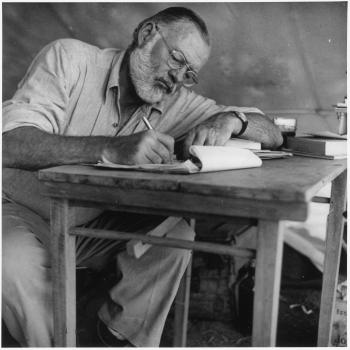Novelist Ernest Hemingway was born on this day in 1899.

Event Description
At 17, Ernest Hemingway began his literary career as a newspaper writer. In 1926, his first major work, The Sun Also Rises, was published. This novel, as well as A Farewell to Arms and For Whom the Bell Tolls, were based on his experiences in World War I and the Spanish Civil War. Considered to be one of his best works, The Old Man and the Sea was published in 1952, two years before he was awarded the Nobel Prize in Literature.
Classroom Activity
Have your students examine the ways different authors treat the subject of war in their writing.
- Have your students read For Whom the Bell Tolls or A Farewell to Arms, as well as a war novel by another author. Some choices include Stephen Crane's The Red Badge of Courage, Erich Maria Remarque's All Quiet on the Western Front, or Walter Dean Myers' Fallen Angels.
- Then ask individual or small groups of students to compare and contrast the way the two authors have depicted war in their novels, using the Interactive Venn Diagram. Students should examine ways the authors use figurative language, characterization, point of view, and other plot elements to tell the story.
- Finally, have students share their Venn diagrams as a whole group.
You may wish to use this activity as a term project and have students use their research to write comparative essays on the two chosen novels. Have them use the Compare & Contrast Map to plan their work.
Websites
PBS offers this collection of Hemingway resources. There are virtual tours, images, and information about key locations in his life, including Spain, Africa, Key West, Cuba, and more.
This page features information about Hemingway's Nobel Prize. Included are links to a biography, his presentation speech with an audio clip, a critical article, and other information.
The website of the Ernest Hemingway Foundation includes a variety of resources on the author.
The National Portrait Gallery offers this exhibition of images and information from Hemingway's life. The site includes sections on Hemingway's beginnings in Paris, as well as the middle and final years of his literary career.